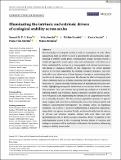Illuminating the intrinsic and extrinsic drivers of ecological stability across scales
Abstract
Our knowledge of ecological stability is built on assumptions of scale. These assumptions limit our ability to reach a generalizable and mechanistic understanding of stability under global environmental change. Moving towards a multiscale approach—across space, time and environment—will allow us to better understand the intrinsic (e.g., demographic) and extrinsic (environmental) drivers of ecological stability. In this perspective, we review multiple sources of variation responsible for shaping ecological dynamics, and how scale affects our observation of these dynamics through its confounding effect on drivers of variation in ecosystems. We discuss the effect of temporal scale when combining empirical dynamic modeling with high‐resolution population time series to consider the time‐varying nature of multispecies interaction networks, highlighting interspecific interactions as an intrinsic driver of community dynamics. Next, we examine energy landscape analysis as a method for inferring stability and transience during community assembly and its interaction with spatial scale, emphasizing the intrinsic role of compositional variability in assembly dynamics. We then examine population dynamics at species' range margins and show how considering the interaction between spatial and temporal environmental heterogeneity, an extrinsic driver of population dynamics, can facilitate a nuanced understanding of population expansions, range shifts, and species invasions. Finally, we discuss broadly how the sources of intrinsic and extrinsic variation interact with each other and with spatiotemporal scale to shape ecological dynamics. Better recognition of the scale‐dependent nature of the relationship between drivers of variation and ecological dynamics will be invaluable to illuminate the dynamics influencing ecological stability across scales.
Citation
Ross , S R P-J , Suzuki , Y , Kondoh , M , Suzuki , K , Villa Martín , P & Dornelas , M 2021 , ' Illuminating the intrinsic and extrinsic drivers of ecological stability across scales ' , Advances in Ecological Research , vol. Early View . https://doi.org/10.1111/1440-1703.12214
Publication
Advances in Ecological Research
Status
Peer reviewed
ISSN
0912-3814Type
Journal article
Description
Funding information: British Ecological Society, Grant/Award Number: TT19/1029; Core Research for Evolutional Science and Technology, Grant/Award Number: JPMJCR13A2; Irish Research Council, Grant/Award Number: GOIPG/2018/3023; Japan Science and Technology Agency, Grant/Award Number: 19H05641; Japan Society for the Promotion of Science, Grant/Award Numbers: 16H04846, JP20J10699.Collections
Items in the St Andrews Research Repository are protected by copyright, with all rights reserved, unless otherwise indicated.

